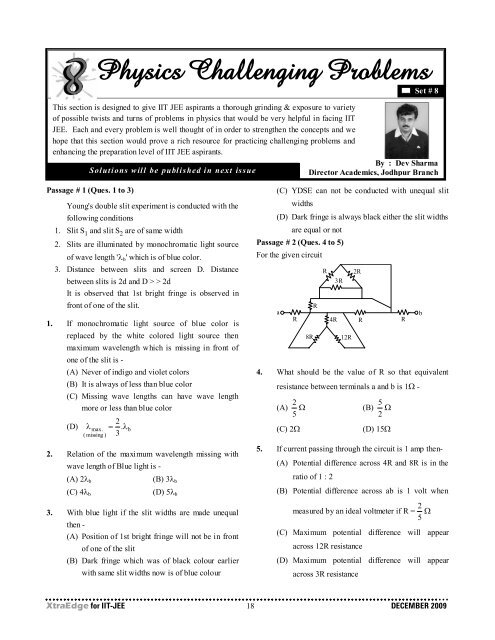You also want an ePaper? Increase the reach of your titles
YUMPU automatically turns print PDFs into web optimized ePapers that Google loves.
Physics Challenging Problems<br />
Set # 8<br />
This section is designed to give <strong>IIT</strong> <strong>JEE</strong> aspirants a thorough grinding & exposure to variety<br />
of possible twists and turns of problems in physics that would be very helpful in facing <strong>IIT</strong><br />
<strong>JEE</strong>. Each and every problem is well thought of in order to strengthen the concepts and we<br />
hope that this section would prove a rich resource for practicing challenging problems and<br />
enhancing the preparation level of <strong>IIT</strong> <strong>JEE</strong> aspirants.<br />
By : Dev Sharma<br />
Solutions will be published in next issue<br />
Director Academics, Jodhpur Branch<br />
Passage # 1 (Ques. 1 to 3)<br />
Young's double slit experiment is conducted with the<br />
following conditions<br />
1. Slit S 1 and slit S 2 are of same width<br />
2. Slits are illuminated by monochromatic light source<br />
of wave length 'λ b ' which is of blue color.<br />
3. Distance between slits and screen D. Distance<br />
between slits is 2d and D > > 2d<br />
It is observed that 1st bright fringe is observed in<br />
front of one of the slit.<br />
1. If monochromatic light source of blue color is<br />
replaced by the white colored light source then<br />
maximum wavelength which is missing in front of<br />
one of the slit is -<br />
(A) Never of indigo and violet colors<br />
(B) It is always of less than blue color<br />
(C) Missing wave lengths can have wave length<br />
more or less than blue color<br />
(D)<br />
λ<br />
2 = λ<br />
max . .<br />
( missing ) 3<br />
b<br />
2. Relation of the maximum wavelength missing with<br />
wave length of Blue light is -<br />
(A) 2λ b<br />
(B) 3λ b<br />
(C) 4λ b<br />
(D) 5λ b<br />
3. With blue light if the slit widths are made unequal<br />
then -<br />
(A) Position of 1st bright fringe will not be in front<br />
of one of the slit<br />
(B) Dark fringe which was of black colour earlier<br />
with same slit widths now is of blue colour<br />
(C) YDSE can not be conducted with unequal slit<br />
widths<br />
(D) Dark fringe is always black either the slit widths<br />
are equal or not<br />
Passage # 2 (Ques. 4 to 5)<br />
For the given circuit<br />
a<br />
R<br />
8R<br />
R<br />
R<br />
4R<br />
3R<br />
12R<br />
4. What should be the value of R so that equivalent<br />
resistance between terminals a and b is 1Ω -<br />
2 5<br />
(A) Ω (B) Ω<br />
5 2<br />
(C) 2Ω<br />
2R<br />
R<br />
(D) 15Ω<br />
5. If current passing through the circuit is 1 amp then-<br />
(A) Potential difference across 4R and 8R is in the<br />
ratio of 1 : 2<br />
(B) Potential difference across ab is 1 volt when<br />
measured by an ideal voltmeter if R = 5<br />
2 Ω<br />
(C) Maximum potential difference will appear<br />
across 12R resistance<br />
(D) Maximum potential difference will appear<br />
across 3R resistance<br />
R<br />
b<br />
XtraEdge for <strong>IIT</strong>-<strong>JEE</strong> 18 DECEMBER 2009

















